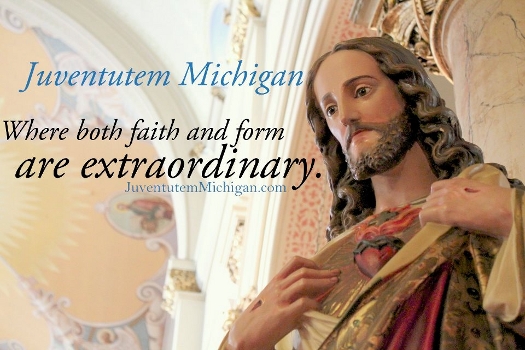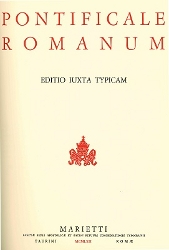
"I will go in unto the Altar of God
To God, Who giveth joy to my youth"
Tridentine Community News by Alex Begin (October 18, 2015):

October 18, 2015 – Twenty-first Sunday After Pentecost
Distinguishing Characteristics of a Pontifical Mass
2015 has brought us a spate of local Pontifical Masses in the Extraordinary Form. First was Bishop Boyea’s Mass for Juventútem at St. Patrick Church in Brighton, Michigan. Then came Bishop Hanchon’s Juventútem Mass at St. Augustine-St. Monica Church in Detroit. Next up is Bishop Hanchon’s Mass and Confirmations for the Oakland County Latin Mass Association at the Academy of the Sacred Heart Chapel on Sunday, November 8 at 9:45 AM. Last is Bishop Boyea’s Mass at St. Mary Star of the Sea in Jackson, Michigan on Sunday, December 6 at 12:15 PM. It is therefore worth mentioning the unique aspects of a Pontifical Mass. First, there are several types of Pontifical Mass:
In a Pontifical Low Mass, the bishop is assisted by two “Chaplains”, one of whom must be in major orders, i.e. a deacon or above. Typically the Chaplain in orders stands to the bishop’s right and functions as a quasi-deacon. The other Chaplain stands to the bishop’s left and functions as a Master of Ceremonies. One server functions as Bugia Bearer; the Bugia is a hand-candle, held next to the book from which the bishop prays. In the days before electric light, the Bugia had a functional purpose; nowadays it is a sign of the increased dignity of the bishop. Before Mass the bishop prays at a faldstool (typically a small bench or a kneeler), before the High Altar. His vestments are arranged on the altar. The servers come out and help him vest, while he prays vesting prayers. Conversely, at the end of Mass, the bishop unvests while praying prayers of thanksgiving, as the servers place his vestments back on the altar. Among the distinguishing vestments of a bishop is a pontifical dalmatic, a thinner version of the deacon’s vestment, worn under the chasuble. Nowadays it can be hard to find a pontifical dalmatic, so it is not always possible for a bishop to wear one. Though a Pontifical Blessing concludes the Mass, no mitre or crosier is used; those are reserved for the following two types of Pontifical Masses:
A Pontifical Solemn Mass is celebrated by the Ordinary of a diocese. It is an extremely elaborate ceremony, with the bishop seated at a throne and served by numerous sacred ministers. Multiple priests are needed for this form of the Mass, and as a result it is rarely seen. Several years ago, former Diocese of Lansing Bishop Carl Mengeling celebrated a Pontifical Solemn Mass at All Saints Church in Flint. Experts from the Fraternity of St. Peter were brought in to coordinate the innumerable details.
A Pontifical Mass at the Faldstool is almost as elaborate as a Pontifical Solemn Mass. This is the form of Mass that an Auxiliary Bishop, or an Ordinary in a diocese other than his own, would celebrate. The principal difference is that the bishop is seated at a more humble faldstool, or bench, rather than at a throne. Chicago Auxiliary Bishop Joseph Perry celebrated such a Mass at St. Josaphat Church during the 2010 Latin Liturgy Association National Convention. Fr. Scott Haynes from St. John Cantius in Chicago directed this similarly complex ceremony.
In recent years, a new form of Pontifical Mass has become popular, for purely pragmatic reasons: A Pontifical Missa Cantata. This form of the Mass was not identified in older liturgical books, but then again neither was a Missa Cantata celebrated by a priest (alone). In olden days it was presumed that priests either celebrated Low Mass or Solemn High Mass, because clergy were abundant to serve as Deacon and Subdeacon. The Missa Cantata evolved as clergy became sparser. Likewise in our age, bishops are less inclined to celebrate the lengthy and complex Pontifical Solemn Mass and Pontifical Mass at the Faldstool, but also recognize that a Pontifical Low Mass without music is inappropriately simplistic. A Pontifical Missa Cantata is the logical compromise. As Fortescue’s Ceremonies of the Roman Rite Described explains, a Missa Cantata is an upgraded Low Mass, not a downgraded Solemn High Mass,thus the ceremonies are essentially the same as a Pontifical Low Mass. It is this form of Pontifical Mass we usually see in metro Detroit and Windsor.
A bishop uses two special books: The Roman Pontifical is the book of Sacraments (Confirmation, Ordination, etc.), while the Pontifical Canon takes the place of the Altar Cards and Altar Missal, providing the unchanging Ordinary of the Mass. An Altar Missal is still used for the Propers.
Tridentine Masses Commence in Texarkana and Fort Hood
We’re pleased to report that two of the groups that took advantage of Extraordinary Faith’s priest training have commenced their own Tridentine Masses: Fr. Michael Adams of Sacred Heart Church in Texarkana, Texas now offers a Tridentine Mass every Thursday at 6:00 PM. Sunday Masses are planned for the future. See: http://www.sacredhearttex.org/123.
Assisted by Sergeant Major John Proctor, Fr. Lito Amande has begun to offer Sunday Low Masses at 3:00 PM at the Fort Hood, Texas army base, only six weeks after the training was provided. Almost 40 souls attended the first Mass. The historic Old Post Chapel has become a primarily Catholic facility as a result of this effort. Photos of the first Mass are available at: https://www.facebook.com/AmysBottomLineUpFront/posts/10156075637810177
Tridentine Masses This Coming Week
- Mon. 10/19 7:00 PM: Low Mass at St. Josaphat (St. Peter of Alcantara, Confessor)
- Tue. 10/20 7:00 PM: Low Mass at Holy Name of Mary (St. John Cantius, Confessor)
- Sun. 10/25 9:45 AM: High Mass at OCLMA/Academy of the Sacred Heart (Christ the King) – Celebrant: Msgr. Arthur Calkins, retired English Correspondence Secretary of the Pontifical Commission Ecclésia Dei at the Vatican. A reception for Msgr. Calkins will follow the Mass.



No comments:
Post a Comment